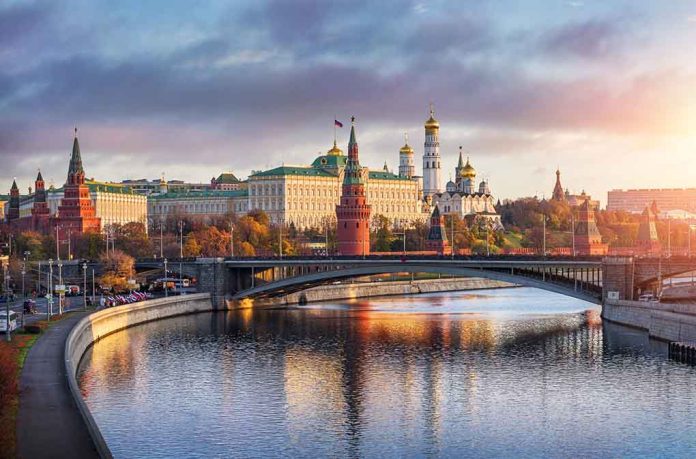
Russia’s population crisis deepens as birth rates plummet to record lows, forcing the nation to rely on migrants for economic survival.
At a Glance
- Russia’s birth rate has fallen to its lowest level in 25 years, with fewer than 100,000 births in June 2024.
- The ongoing war with Ukraine has exacerbated the population crisis, causing increased mortality and mass exodus.
- Russia faces a severe worker shortage, with a record shortfall of 5 million workers by the end of 2023.
- The Kremlin acknowledges the need for migrants to address the shrinking domestic workforce.
- Demographic challenges could lead to Russia’s economy falling behind Indonesia’s by 2026.
Russia’s Demographic Nightmare Unfolds
Russia is grappling with a demographic crisis of unprecedented proportions. The country’s birth rate has plummeted to its lowest level in a quarter-century, with births falling below 100,000 for the first time in June 2024. This alarming trend has set off warning bells in the Kremlin, as the nation faces the prospect of a rapidly shrinking workforce and an uncertain economic future.
The ongoing conflict in Ukraine has only served to exacerbate these demographic woes. With over 300,000 Russian troops killed or injured and approximately one million citizens fleeing the country, the war has dealt a severe blow to Russia’s already fragile population dynamics. These factors have combined to create a perfect storm of demographic decline, threatening the very fabric of Russian society and its economic prospects.
Kremlin Sounds the Alarm
The gravity of the situation has not been lost on Russian officials. Kremlin spokesperson Dmitry Peskov has been frank in his assessment of the crisis, highlighting the urgent need for action.
“This is catastrophic for the future of the nation,” Peskov stated, underscoring the dire implications of Russia’s demographic decline. “It [the birth rate] is now at a terribly low level—1.4 [births per woman]. This is comparable to European countries, Japan, and so on.”
The fertility rate in 2023 stood at a mere 1.41 births per woman, well below the replacement rate of 2.0 needed to maintain a stable population. This stark reality has forced the Russian government to confront the uncomfortable truth that the nation’s future may depend on immigration to sustain its workforce and economy.
Migrants: A Necessary Solution
As Russia’s domestic labor pool continues to shrink, the country finds itself increasingly reliant on migrant workers to fill critical gaps in its workforce. Peskov’s acknowledgment of this dependency marks a significant shift in the Kremlin’s rhetoric on immigration.
“Russia needs migrants in order to develop because of its dwindling domestic workforce,” Peskov stated in a recent interview. “Migrants are a necessity.”
This admission comes as Russia grapples with a record labor shortage, with an estimated shortfall of 5 million workers by the end of 2023. The country has already resorted to using migrant and prison labor to address this deficit, but experts warn that these are not sustainable long-term solutions.
Challenges and Future Outlook
The demographic crisis poses significant challenges for Russia’s future. Experts predict that if current trends continue, Russia’s population could be halved by the end of the century. This drastic decline would have far-reaching implications for the country’s economic competitiveness and geopolitical standing.
“Unless Russia’s leaders can develop and finance a more effective set of policies, the only solutions to population decline will be a combination of incorporating non-Russian territory and/or immigration from Asia and Africa,” notes Harley Balzer, an expert on Russian demographics.
The Russian government has attempted to address the crisis through various initiatives, including financial incentives for families and legislation banning “child-free propaganda.” However, these efforts have yet to yield significant results. As Russia’s demographic challenges continue to mount, the country faces an uncertain future marked by a smaller, older, and potentially less well-educated population.
A deepening demographic crisis is roiling Ukraine, exacerbated by Russia’s full-scale invasion, with the population dropping by 10 million since 2014, according to @UNFPA.https://t.co/4ypROrTnLq
— UN News (@UN_News_Centre) October 22, 2024
As Russia navigates this demographic minefield, the need for a comprehensive and effective strategy to address population decline becomes increasingly urgent. The country’s ability to adapt to these challenges will play a crucial role in shaping its future workforce, economic growth, and place on the global stage.
Sources:
- https://fortune.com/europe/2024/09/10/russia-demographic-crisis-low-birth-rate-ukraine-war/
- https://www.businessinsider.com/russia-economy-population-decline-worker-shortage-growth-outlook-ukraine-war-2024-8
- https://www.atlanticcouncil.org/content-series/russia-tomorrow/a-russia-without-russians-putins-disastrous-demographics/
- https://insiderpaper.com/russia-says-it-needs-migrants-to-fill-labour-shortage/










